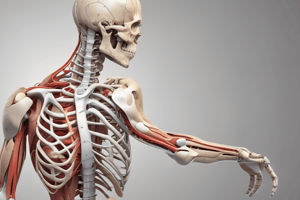Podcast
Questions and Answers
What are the diagnostic criteria for Osteoarthritis (OA)?
What are the diagnostic criteria for Osteoarthritis (OA)?
- Gradual onset, increased stiffness, and pain at end of day (correct)
- Scapular dyskinesis, pain with overhead elevation, and crepitus
- Pain at the top and lateral aspect of the shoulder, weakness, and history of repetitive overhead activity
- Inflammation, partial tearing, and full tear
What are the objective findings for Rotator Cuff Tendinopathy (RTC)?
What are the objective findings for Rotator Cuff Tendinopathy (RTC)?
- Joint pain worsened by movement
- Decreased active and passive range of motion (ROM), crepitus, capsular end-feel, and pain at end-range ROM
- Scapular dyskinesis, pain with overhead elevation, painful arc of movement, crepitus, and tenderness over rotator cuff and biceps insertions (correct)
- Pain at the top and lateral aspect of the shoulder, weakness, history of repetitive overhead activity, and prior trauma
What first line interventions are recommended for Osteoarthritis (OA)?
What first line interventions are recommended for Osteoarthritis (OA)?
- Improving force production, normalizing movement, and addressing mechanics that contributed to the pathology
- Joint mobilizations, stretching exercises, and medical interventions (oral anti-inflammatories) (correct)
- Joint mobilizations, stretching exercises, and medical interventions (corticosteroid injection)
- Patient education, improving tissue tolerance through loaded active exercises, and oral anti-inflammatories
What are the objective findings for Osteoarthritis (OA)?
What are the objective findings for Osteoarthritis (OA)?
Which outcome measure is specifically validated for Adhesive Capsulitis?
Which outcome measure is specifically validated for Adhesive Capsulitis?
What age group is more prevalent in Adhesive Capsulitis?
What age group is more prevalent in Adhesive Capsulitis?
Which condition is associated with risk factors including genetics, female sex, past trauma, advancing age, and obesity?
Which condition is associated with risk factors including genetics, female sex, past trauma, advancing age, and obesity?
Which phase of Adhesive Capsulitis is characterized by substantial ROM deficits and less pain?
Which phase of Adhesive Capsulitis is characterized by substantial ROM deficits and less pain?
What are the common risk factors for Osteoarthritis?
What are the common risk factors for Osteoarthritis?
What are the key phases that occur in individuals with Adhesive Capsulitis?
What are the key phases that occur in individuals with Adhesive Capsulitis?
Flashcards are hidden until you start studying
Study Notes
- The text discusses the diagnosis and treatment of two shoulder conditions: Osteoarthritis (OA) of the glenohumeral joint (GHJ) and Rotator Cuff Tendinopathy (RTC).
- Osteoarthritis (OA):
- Characterized by joint pain worsened by movement.
- Diagnostic criteria: advanced age, previous trauma, gradual onset, increased stiffness, joint pain with activity, and pain at end of day.
- Objective findings: decreased active and passive range of motion (ROM), crepitus, capsular end-feel, and pain at end-range ROM.
- Interventions: patient education, joint mobilizations, stretching exercises, and medical interventions (corticosteroid injection and surgery).
- Rotator Cuff Tendinopathy (RTC):
- Often occurs in middle-aged individuals.
- Diagnostic criteria: pain at the top and lateral aspect of the shoulder, weakness, history of repetitive overhead activity, and prior trauma.
- Objective findings: scapular dyskinesis, pain with overhead elevation, painful arc of movement, crepitus, and tenderness over rotator cuff and biceps insertions.
- Interventions: patient education, joint mobilizations, stretching exercises, and medical interventions (oral anti-inflammatories, corticosteroid injection, and surgery).
- Stages: inflammation, partial tearing, and full tear.
- Common impairments and tests for both conditions: patient education, improving joint mobility, and neurological tests (Full Thickness: External Rotation Lag Sign, Internal Rotation Lag Sign, and Partial Thickness: Painful arc, Neer’s test, Hawkin’s-Kennedy Test, Infraspinatus Muscle Test, and Belly Press Test).
- Interventions for both conditions: improving tissue tolerance through loaded active exercises, improving force production, normalizing movement, and addressing mechanics that contributed to the pathology.
- Outcome measures for both conditions: Patient Specific Functional Scale (PSFS), QuickDASH, Shoulder Pain and Disability Index (SPADI), and Penn Shoulder Scale (PSS).
Studying That Suits You
Use AI to generate personalized quizzes and flashcards to suit your learning preferences.




